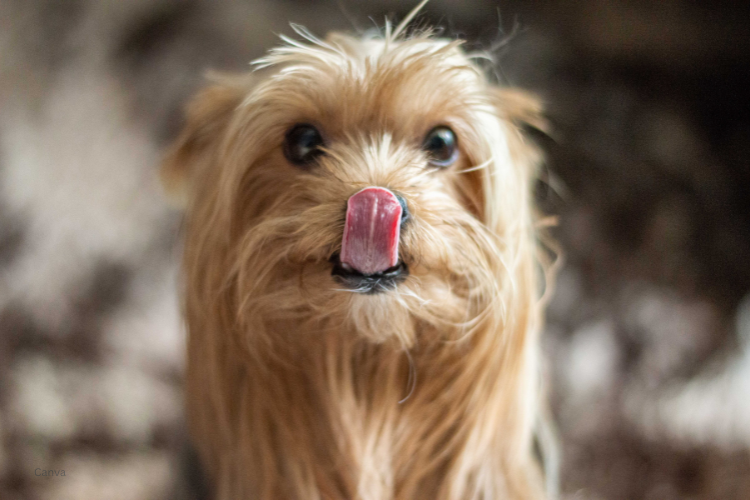Quiet signals that point to hidden trouble.

Dogs often show discomfort in ways that look strange or confusing at first. Many of these behaviors slip by unnoticed because they do not resemble classic symptoms of illness. Instead they appear as small quirks that build gradually into patterns. These tiny shifts can tell a deeper story about what is happening inside the body long before obvious signs appear. Once owners start recognizing the hints, they become far better equipped to support their dogs through early intervention.
The connection between behavior and health becomes clearer when viewed piece by piece. Dogs rarely express pain or illness directly. They rely on subtle gestures, unusual habits and changes in rhythm that reveal what words cannot. As each behavior unfolds into the next, a larger picture emerges, one that turns curiosity into insight for anyone willing to look a little closer.
1. A sudden head tilt lingers far too long.

A dog may tilt its head briefly during play or curiosity, but when the angle becomes persistent, it can signal trouble within the inner ear or nervous system. The tilt often appears during walks or when the dog tries to track sounds. Their balance may shift slightly as they compensate for discomfort that they cannot explain. These early motions may seem harmless until the pattern continues through the day.
As this posture remains, dogs sometimes stumble or hesitate on turns. Their eyes may flicker rapidly as they work to stay oriented. These signs often point to infections or neurological changes. The behavior flows into broader concerns that connect closely with other unusual habits.
2. Excessive air licking begins showing up repeatedly.

Dogs sometimes lick the air while smelling strong scents or tasting residue on their lips. When the action becomes constant, it may indicate nausea, dental pain or digestive upset. Owners might catch their dog pausing mid activity to flick their tongue outward over and over. The movement looks odd because it disrupts the dog’s usual rhythm.
Over time the licking may pair with pacing or swallowing hard. These actions hint at discomfort within the mouth, throat or stomach. The pattern links naturally to the next sign that often appears during moments of physical unease.
3. Repeated stretching points to abdominal discomfort.

Stretching looks pleasant at first, yet dogs dealing with stomach pain or inflammation stretch far more often than normal. They may sink their front legs down while keeping their hind legs straight, holding the pose longer than a typical morning stretch. This posture can help relieve pressure on the abdomen in subtle ways.
As the pattern grows, these stretches appear at random times during the day. Dogs may pause their walks or leave their beds just to stretch again. The habit becomes a quiet message that something deeper is happening internally.
4. Sudden shadow chasing hints at neurological issues.

A dog that begins snapping at invisible shapes or chasing shadows may be experiencing a type of sensory disturbance. These moments often arrive unexpectedly, catching owners off guard. The dog may stare intensely at a blank wall, follow nonexistent movement or try to catch flickers of light that are not there.
With time these episodes can grow more frequent. The dog might seem distant or overwhelmed afterward, almost as if recovering from a confusing experience. This behavior often blends into other signs linked to changes in brain activity or sensory processing.
5. Reluctance to climb stairs develops without explanation.

Dogs who once bounded up steps may suddenly hesitate or pause halfway. They may plant their feet firmly or look back at their owner for reassurance. The hesitation suggests pain in the joints, spine or muscles. Even younger dogs can show this when early inflammation or injury begins affecting movement.
As the reluctance continues, dogs may limit their activity or avoid elevated surfaces entirely. Their body language reveals a discomfort that grows harder to ignore. This shift often complements other mobility related changes appearing at home.
6. Constant paw lifting signals deeper irritation.

Occasional paw lifts help dogs balance or explore surfaces. When the behavior repeats throughout the day, it can highlight pain, nerve sensitivity or injury. The dog may hold one foot off the ground for several seconds, then switch to another. The uneven stance disrupts their normal gait.
Over time the dog may lick the lifted paw or avoid stepping on certain surfaces. This reaction hints at discomfort from inflammation, infection or early arthritis. The subtle limp blends smoothly into the next sign related to cognitive changes.
7. Unexplained wandering during quiet hours raises concern.

Dogs who wander restlessly at night or pace circles in familiar rooms often face cognitive decline or anxiety. They may appear confused about where to settle or stand in corners as if unsure of their surroundings. These motions become more noticeable when the rest of the house is calm.
As the behavior unfolds night after night, the dog’s daytime routine becomes disrupted as well. Their sleep patterns shift, and they may appear more distant or forgetful. This wandering often connects with other age related signals that build slowly through the years.
8. Persistent staring into space suggests neurological strain.

A dog that pauses and stares into empty space may be experiencing partial seizures, disorientation or vision changes. These episodes create moments where the dog appears frozen, unaware of movement around them. Owners might mistake it for daydreaming until the pattern repeats in different contexts.
As these spells lengthen, the dog may become startled when movement resumes. Their reactions appear delayed or out of sync. This quiet symptom often goes unnoticed but carries valuable clues about underlying conditions.
9. Sudden aversion to touch reflects internal pain.

When a friendly dog begins pulling away from petting or flinches unexpectedly, discomfort may be growing beneath the surface. They may avoid being handled around the neck, ribs or lower back. The shift can seem subtle, appearing first as a light lean away before becoming more pronounced.
With time the dog may grow tense during grooming or routine interactions. Their body language becomes cautious in ways that contrast sharply with their usual personality. These signs often point toward muscle strain, skin conditions or early organ inflammation.
10. Excessive drooling emerges in unfamiliar situations.

Some drooling is normal, yet sudden or heavy drooling during calm moments often signals nausea, dental issues or toxin exposure. Dogs may soak their bedding or leave trails as they walk. Their mouth may hang slightly open as saliva gathers faster than they can swallow.
As the drooling persists, they may paw at their face or show trouble eating. These small but persistent signs create a clear message once placed alongside other unusual behaviors. The pattern naturally leads into the last sign linked to breathing changes.
11. Strange breathing rhythms appear during rest.

A dog resting quietly should breathe evenly and calmly. Irregular pacing, rapid breaths or deep gulps during still moments can signal heart problems, respiratory issues or anxiety linked illness. These changes often appear first during naps or nighttime routines.
As the rhythm continues to shift, dogs may become more tired or reluctant to exercise. Their body struggles to balance oxygen needs with underlying stress or medical strain. The full picture becomes clear as each behavior in this list connects to a deeper set of conditions that deserve careful attention and early veterinary guidance.
